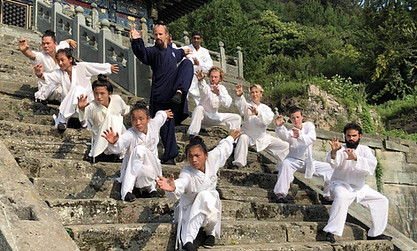
External System
The external system as taught through the Ways of Wudang is a very comprehensive curriculum. The system includes basic training and conditioning, stances and footwork, kicks and flexibility, and empty hand and weapon styles of training.
External training is designed to condition the body. Each style within the system has its own unique qualities and benefits the practitioner in many ways. The list of these benefits can be quite extensive but a simple summary would be achieved by understanding the goals of the external training system. First and foremost the training is meant to improve health and longevity. The layers go deeper than this however and as we transform the body and mind, we are also preparing ourselves for the internal practices to come.

At the risk of oversimplifying an entire system, the external arts are a method for us to create a stable environment not just for our physical self, but eventually for our mental, emotional, and spiritual selves as well. These practices are the first step in the San Feng Lineage towards this goal and for serious practitioners they should be treated as such. Of course the external practices may already be enough for many students. They may only be looking for a physical practice to improve, rehabilitate, or maintain their health. These practices can be utilized by everyone. Even so, it is also important to understand their full context in relation to the history of San Feng Lineage and Chinese wushu.
We begin with the basic external empty hand forms. These teach the fundamental stances, movements, and skills of Chinese martial arts. Through these initial practices we teach our body the "language" of the system. Once a solid foundation is laid we move forward into more intermediate and advanced sets, even incorporating weapons into our training. The emphasis throughout training is on self cultivation, using the movements and techniques to stretch and strengthen the body. In this way, the external system tempers our body and mind, helping us to develop dexterity and discipline.
For the above reasons, the external curriculum creates "shape" of the system. It is a necessary framework from which we build the internal training upon. In the links below you can find information for the specific forms taught through the Ways of Wudang. The full system is quite large with 20 external forms in total. This is in addition to all of the basic training the goes alongside each individual practice. There is also free online study material available through Wudang Way on Youtube as well as private classes available upon inquiry here.
Complete List of Empty Hand Sets

Complete List of Weapon Sets
基本拳 Jīběn Quán Basic Fist
玄功拳一路 Xuán Gōng Quán Yīlù Mysterious Skill Fist (Pt 1)
玄功拳二路 Xuán Gōng Quán èr Lù Mysterious Skill Fist (Pt 2)
玄功拳三路 Xuán gōng quán sān lù Mysterious Skill Fist (Pt 3)
玄真拳 Xuán zhēn quán Mysterious True Fist
伏虎拳 Fú hǔ quán Taming the Tiger Fist
龙华拳 Lóng Huá Quán Dragon Fist
玄武拳 Xuánwǔ quán Xuan Wu Fist
八極拳 Bā jí quán Eight Poles Fist
形意拳 Xíng yì quán Shape-Intention Fist
八卦掌 Bāguà zhǎng Eight Trigrams Palm
玄功刀 Xuán gōngdāo Mysterious Skill Broadsword
拂尘 Fúchén (Horsehair) Whisk
玄门剑 Xuán mén jiàn Mysterious Gate Sword
龙华剑 Lónghuá jiàn Dragon Sword
八仙剑 Bā xiānjiàn Eight Immortals Sword
八仙棍 Bāxiān gùn Eight Immortals Staff
子午槍 Zǐwǔ qiāng Meridian Spear
五龙大刀 Wǔ lóng dàdāo Five Dragon Halberd
方便铲 Fāngbiàn chǎn Convenient Shovel



